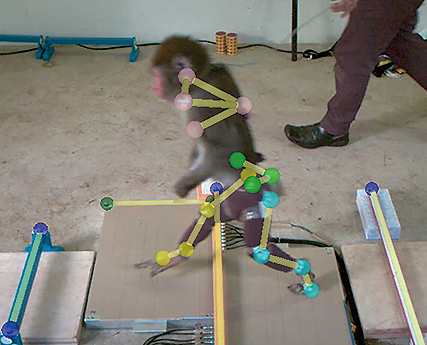Disclaimer: machine translated by DeepL which may contain errors.
Anthropology + Mechanical Engineering: A Single Person's Approach to Fusion of Different Fields
Naomichi Ogiwara, Professor, Department of Biological Sciences
I assumed the position of Professor in the Department of Biological Sciences in March 2018. My previous position was Professor in the Department of Mechanical Engineering, Faculty of Science and Technology, Keio University. Before that, I was Research Associate and Assistant Professor at Department of Biological Sciences, Graduate School of Science, Kyoto University, and before that, I was a graduate student at Department of Mechanical Engineering, Keio University. You may find it strange that I have been moving back and forth between mechanical engineering and biology, two fields that are not usually considered to be opposites.
Ever since I was a student, I have been consistently interested in human bipedal locomotion. As a university student, I learned as my studies progressed that it was extremely difficult to engineer a machine that could walk on two legs. On the other hand, we can easily walk on two legs on stairs, hills, and uneven terrain without falling down. In order to build a machine with more advanced locomotion ability, we thought it was necessary to understand the walking mechanism of living organisms in more detail, and began studying human bipedal locomotion. Specifically, we constructed a computer model of the human musculoskeletal system and combined it with a model of the nervous system that controls each muscle to walk without falling down, and reproduced human bipedal locomotion in a virtual space to understand its mechanics and neural control mechanisms.
I was expected to apply these bipedal walking simulations to the study of the evolution of human upright bipedalism, and although I had no knowledge of biology at the time, I was fortunate enough to dive into the world of anthropology. At that time, I was strongly reminded that although I thought I had studied the human body structure and motor functions, my understanding of their true nature was completely inadequate. Humans evolved from primates by adapting to bipedalism, and their body structure and motor functions are also a product of evolution. However, when we look only at humans, we do not realize the uniqueness of humans. To correctly understand human structure and locomotion, it is essential to view things from an evolutionary perspective by contrasting humans with other animals, but I realized that such a perspective was completely lacking. Since then, I have been conducting experimental studies comparing human musculoskeletal structure and bipedal locomotion mechanisms with those of other primates, such as Japanese monkeys, and simulation studies that can withstand biological considerations, which can only be done by a person with a mechanical engineering background conducting actual research in the field of anthropology. This is the case with the simulation research that can withstand biological considerations, which is possible only by conducting actual research in the field of anthropology. It is thanks to this bold move that we are now able to develop a unique, though by no means spectacular, research program in the world.
 |
|||
| Analysis of Japanese macaque bipedal locomotion using a motion capture system and floor reaction force meter | |||
It has been pointed out that collaboration between different fields is important for launching innovative research and creating new value. However, it is actually very difficult for researchers with different backgrounds to completely share each other's interests and awareness of problems and to work together to solve them. However, if one researcher changes his/her field of expertise at some point and actually conducts research in two different fields, it may take some time, but true fusion of different fields can be achieved, and this will be a driving force to open up new values. I believe that actively encouraging young researchers to make bold and unusual transfers that promote "one-person fusion of different fields" could be a catalyst for the creation of new and interesting value.
Published in the March 2021 issue of Faculty of Science News


